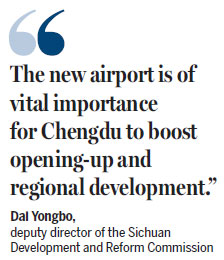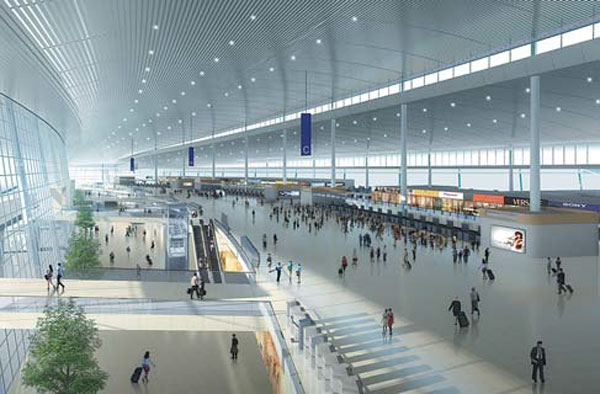Chengdu aims to be transport hub

|
An artistic illustration of Chengdu Tianfu International Airport, which began construction on May 27, making Chengdu the third city on the Chinese mainland to have a second civilian airport. Photos provided to china Daily |
|
The new airport will handle 40 million passengers annually by 2025. |
Second civil airport will advance province's opening-up, Li Yu and Peng Chao report.
Chengdu, a mega city in western China, is building itself into a world-class aviation hub.
The city started construction of a new airport - Chengdu Tianfu International Airport - on May 27, making it the third city on the Chinese mainland to have a second civil airport.
With an investment of 71.86 billion yuan ($11.7 billion), the Chengdu Tianfu International Airport will be located in Lujia township, 50 kilometers southeast of downtown Chengdu.
It is expected to be completed in 2019 and go into operation in 2020, said Dai Yongbo, deputy director of the Sichuan Development and Reform Commission.
"The new airport is of vital importancefor Chengdu to boost opening-up and regional development," he said.
Liu Yi, deputy chief architect of the China Southwest Architectural Design and Research Institute, which designed the new airport, said the first phase of the project would include three runways, with the capacity to handle 320,000 flights, 40 million passengers and 700,000 metric tons of cargo annually by 2025.
The long-term target for the airport is to have six runways, with annual capacity of 90 million passengers and 2 million tons of cargo.
"The Chengdu new airport, which is designed to lead the times, will feature smart services, natural and cultural landscape and green technology," Liu said.

The airport will be highly intelligent and automatic with the use of smart technology, such as an electronic luggage tracing system, self-boarding system, intelligent baggage transport system and biometrics identification technology, Liu said.
The airport will integrate the terminals with all means of transportation, including intercity railway, subway, buses, taxis and private cars. Passengers will be able to walk to any of the transportation options from the central part of the terminal within only a few minutes.
Through the intercity railway, highways and subway linked to the new airport, passengers can easily reach downtown Chengdu and its neighboring cities. The subway that will connect the new airport with downtown will travel at speeds as high as 140 km/h, so a one-way trip will only take half an hour.
Liu said the design of the new airport was inspired by traditional Shu culture. "For example, the main frames of the terminals look like four Sun Birds in the ancient mythology of the Shu State (221-263)," he said.
To give the visitors a first impression of Chengdu and its surroundings, the airport will have eight courtyards displaying representative natural and cultural landscapes of the city and Sichuan province, including Qingcheng Mountain, the Temple of Marquis, Sanxingdui Site Museum and Jiuzhaigou Valley.
"The airport will be environmentally friendly and energy-saving," Liu said. It will make wide use of new materials and adopt such advanced technology as an intelligent energy management system, photovoltaic power generation, rainwater collection and a recycling system.
According to the plan, the airport will not only be a transportation building, but a giant traffic complex that combines accommodation, offices, shopping, dining and entertainment.
Liu said the airport has also planned an economic zone to boost the development of an airport economy, making it an important growth engine for city development.
Aviation hub
With rapid economic development and more frequent international exchanges, Chengdu has seen a sharp increase in its air traffic in recent years.
Chengdu Shuangliu International Airport is the fourth-busiest airport on the Chinese mainland, after Beijing Capital International Airport, Shanghai Pudong International Airport and Guangzhou Baiyun International Airport.
Chengdu Shuangliu handled 42 million passengers in 2015, an increase of 12.1 percent year-on-year, according to statistics released by Civil Aviation Administration of China.
The number of overseas passengers through the Shuangliu airport exceeded 4 million in 2015, and its cargo transport reached 556,600 tons, both ranked first in western China.
The Shuangliu airport is almost running at full capacity, but its passenger volume has kept rising. "Experts expect the annual aviation passenger volume in Chengdu to reach 75 million by 2025," said Zhang Xicheng, assistant to the general manager of the Sichuan Province Airport Group.
To meet the increasing needs of air transportation and boost the city's opening up, Chengdu started the planning of a new airport in 2011. In January 2015, the central government approved the construction of the new airport.
Zhang said the new airport would serve international passenger routes and most international cargo routes, while Shuangliu airport would handle domestic flights and some international cargo routes.
Dai said Chengdu is blessed with geographical advantages as many of the air routes from China to Europe fly over the city. The new airport is expected to attract more international air routes, making Chengdu a key hub linking western China with the world.
Chengdu already has the largest number of international routes in China's central and western region. The 88 international routes connect it to cities around the world, including San Francisco, London, Paris, Moscow, Doha and Melbourne.
The city launched 10 new international flights last year alone. In February, Sichuan Airlines launched a direct route between Chengdu and Prague, the sixth direct route linking the city to Europe.
Chengdu is also planning to open direct routes to other cities including New York, Sydney, Rome and Johannesburg this year, according to the Sichuan Port and Logistics Office.
The city will open at least three international direct routes in each of the next five years, which will enable the city to become a regional hub of both international and domestic airline routes, according to an official at the Chengdu Port and Logistics Office.
"We will strengthen the city's status as a national-level aviation hub and gateway in western China, building it into an ideal transfer station that connects Europe, Africa and the Middle East to Southeast Asia, Oceania, and North America," the official said.
Contact the writers at liyu@chinadaily.com.cn and pengchao@chinadaily.com.cn
(China Daily 05/30/2016 page22)














